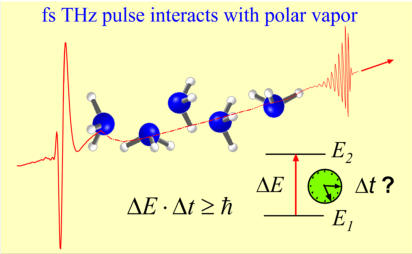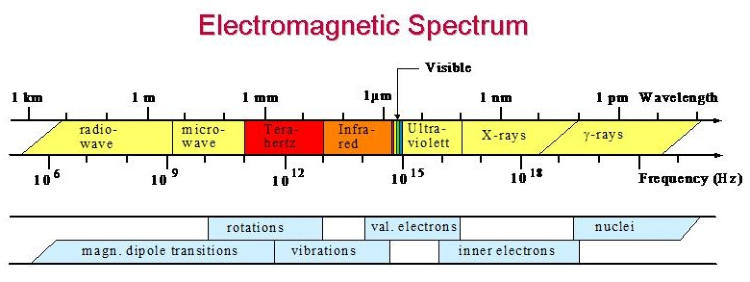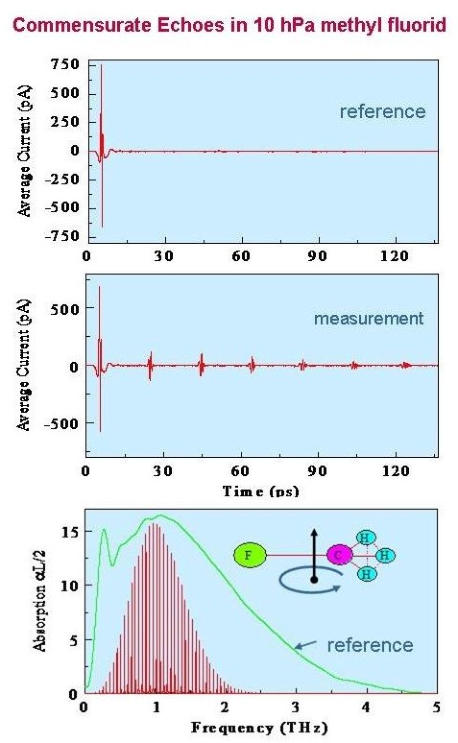
e) Time-Resolved Spectroscopy of THz Coherent Transients
In recent years experiments with ultrashort pulses were almost exclusively restricted to the visi-
ble and infrared spectral range. However, the newly developed terahertz beam sources, produ-
cing subpicosecond pulses of terahertz radiation, have made accessible a new frequency range
for time domain spectroscopy and the studies of fast transients.
These pulses essentially consist of a single cycle over the pulse duration of typically 300 fs, and
are characterized by a transform-limited white spectrum extending from low frequencies up to
5 THz. This frequency range, midway between the microwave and infrared frequencies, is im-
portant owing both to the samples that can be investigated and to the unusual experimental
conditions encountered with these THz pulses.
They allow to study gases, liquids and solids in a frequency range, which in recent years was not
or only hardly accessible. The time response of TeraHertz-matter interactions can be studied by
observing the pulse reshaping of femtosecond THz-pulses propagating through resonant and
nonresonant media. By precisely modeling the pulse interaction with these samples the mea-
surements can be analyzed directly in the time domain or parallel in the frequency domain by
Fourier transforming the pulses and comparing them with theoretical spectra. This gives de-
tailed insight into the material properties in the THz frequency range.
Generation and Detection of THz-Pulses
Meanwhile different techniques are known to generate and detect THz radiation, e.g., by mixing
optical frequencies on an
optoelectronic chip or using
nonlinear crystals as sour-
ces and detectors.
A very successful technique
for generating and detec-
ting these pulses with ex-
cellent signal-to-noise ratios
is to use photo-conducting
antenna chips irradiated
with ultrashort laser pulses.
When the transmitting chip is additionally supplied with a voltage, the incoming light pulses
instantaneously create photo carriers which are accelerated in the supplied electric field. The
rapid changes in conductivity result in short pulses of the electric current, and it is well known
from classical electrodynamics that a changing current causes a radiation field which is pro-
portional to the time derivative of the current.
The so-called Hertzian dipole antennas are fabricated on an ion-implanted silicon-on-sapphire
wafer and are located in the middle of two coplanar transmission lines separated from each
other by 10 µm. The antenna gap is 5 µm wide and photoconductively shortened with 60 - 70 fs
laser pulses coming at a rate of 100 MHz from a colliding pulse mode-locked (CPM) dye laser or
a Ti:Sapphire laser.
The emitted TeraHz radiation is collimated by a silicon lens and paraboloidal mirror into a highly
directional beam with a 25 mrad divergence. After a 50 cm propagation distance this beam is fo-
cused by an identical combination of mirror and lens onto the receiving antenna chip which in
this case is of the same design as the transmitter.
The electric field of the THz radiation induces a voltage across the gap and thus replaces the
voltage source of the transmitting antenna. The actual electric field of a THz pulse is now samp-
led by photoconductively shorting the antenna gap with laser pulses from a detection beam
and monitoring the respective photocurrent in the antenna as a function of the time delay
between the optical excitation and probe pulse.
Special Properties and Advantages of Time Resolved THz Spectroscopy
•
The measured average antenna current directly represents the electric field amplitude of
the pulses in contrast to the optical region, where only intensities are registered and the
phase information of the field is lost.
•
The pulses are measured with a time resolution of 65 fs.
•
It's particularly noteworthy that these pulses are detected with a signal-to-noise ratio of
better than 5.000:1, which for the power corresponds to a ratio of 25 Mio:1. The average
power of the THz radiation is approximately 10 nW and therefore the NEP of the system
only 10
-15
Watt/Hz
1/2
.
•
Compared with a helium cooled bolometer this setup is more than 1.000x more sensitive,
although it is operated at room temperature.
•
The reason for this high sensitivity is mainly due to the subpicosecond gating at the
detector measuring only events within this short time interval, and on the other hand the
integration over more than 10 Mio pulses at a detection bandwidth of 1 Hz at the current
amplifier.
•
This coherent detection almost completely suppresses thermal or shot noise, processes
limiting the conventional techniques.
•
The THz pulses are unique in terms of their pulse duration and corresponding bandwidth.
•
They essentially consist of a single cycle and are characterized by a transform-limited white
spectrum, in this case extending up to 5 THz.
•
In this frequency range up to now no proper radiation for time resolved measurements of
fast transients is available, and
•
no other system with this S/N ratio, high sensitivity and broad spectral range is known.
Measurement of Gases
Almost all polar molecules have their rotational absorption lines in this spectral range and
therefore can be investigated with these exceptional pulses. As an example of a measurement
with symmetric top molecules is shown a plot with 10 hPa methyl fluoride in a gas cell.
For the analysis of such measurement
two scans are necessary, one without
the vapor to determine the input pulse,
and a second one with the vapor in the
gas cell, to register the pulse being re-
shaped and attenuated due to the pro-
pagation though the sample.
At this low pressure the input pulse is
only slightly affected, but some signi-
ficant changes in the pulse structure
are already observed. The main pulse
is followed by a series of coherent
transients reradiated by the vapor
every 20 ps after the excitation pulse.
This phenomenon is best understood
when switching to the frequency do-
main. The spectrum of the input pulse
is shown in the lower plot as the green
line in direct comparison with the ab-
sorption spectrum of MF. The THz pul-
se which covers this full spectrum, ex-
cites the molecules simultaneously on
a multitude of pure rotational lines and
the molecules respond to this excita-
tion as a phased array of oscillators by
re-radiating a free-induction decay sig-
nal consisting of coherent transients.
Because the MF molecule is distinguished by absorption lines with an almost constant frequen-
cy separation, a periodic rephasing and dephasing of the entire ensemble of more than 50 exci-
ted transitions occurs during the free induction decay, manifest as a train of subpsec THz pulses
with a repetition rate equal to the frequency separation between adjacent lines. This situation is
quite similar to mode-locking of lasers.
Because of the rephasing of the dipoles and the commensurate frequencies involved, we term
these periodic pulses "THz commensurate echoes".
What New Informations are Derived from THz-Spectroscopy?
•
In the THz frequency range we observe a transition from the classical collision theory with a
Lorentzian lineshape to a Van Vleck-Weisskopf line shape of collisionally broadened lines.
•
From this lineshape we get informations on the temporal response of the polar molecules
which can align to the electric field of the THz pulses in the presence of molecular colli-
sions.
•
The alignment characterizes the thermalization to the THz-field in the presence of colli-
sions.
•
From this time response we derive the molecular collision time.
•
Also can be measured the absorption and collisional broadening at zero frequency origi-
nating from molecular tunneling.
•
New analyses for the molecular respon-
se time allow a generalized unification
of the basic collision and line-shape
theories of Lorentz, van Vleck-Weiss-
kopf and Debye which can be described
by our molecular response theory
(MRT).
•
This shows that the applied THz experi-
mental set-up allows the direct obser-
vation of the ultimate time response of
molecules to an external applied electric field in the presence of molecular collisions.
•
This response is limited by the uncertainty principle and is determined by the inverse of the
spitting frequency between adjacent levels.
Doctoral Theses
J. Zhao
Zeitaufgelöste Terahertz-Spektroskopie an Polymeren, Silizium und Ammoniak
School of Electrical Engineering, Helmut-Schmidt-University, Hamburg 2003,
Fortschr.-Ber. VDI Reihe 8 Nr. 1010, Düsseldorf, VDI-Verlag 2003, ISBN: 3-18-501008-6
C. Fox
Singe Cycle TeraHertz Pulse Propagation in Water
School of Electrical Engineering, Helmut-Schmidt-University, Hamburg 2009, and
Dartmouth College, New Hampshire
B. Heinemann
Weiterentwicklung und Einsatz eines Mess-Systems mit asynchroner Abtastung zur zeitaufgelösten Terahertz-
Spektroskopie an Gasen
School of Electrical Engineering, Helmut-Schmidt-Uiversity, Hamburg 2014
Refereed Publications in Journals and Conference Digests
H. Harde, S. Keiding, D. Grischkowsky
THz Commensurate Echoes: Rephasing of Molecular Transitions in Free-Induction Decay
Physical Review Letters 66, p. 1834 (1991)
H. Harde, S. Keiding, D. Grischkowsky
THz Coherent Transients from N
2
O Vapor
in ''Quantum Electronics Laser Science'', 1991 Technical Digest Series (Optical Society of America, Washington,
D.C. 1991), p. 248 (1991)
H. Harde, D. Grischkowsky
Coherent Transients Excited by Subpicosecond Pulses of Terahertz Radiation
Journal Optical Society America B 8, p. 1642 (1991)
H. Harde, D. Grischkowsky
Time-Domain Spectroscopy of Molecular Vapors with Subpicosecond Pulses of THz Radiation
in:''Ultrafast Processes in Spectroscopy'', Institute of Physics Conference Series No. 126, ed. by A. Laubereau
and A. Seilmeier (IOP Publishing Ltd, Bristol, 1992), pp. 217-222 (1992)
D. Grischkowsky, N. Katzenellenbogen, H. Harde
Time-Domain Spectroscopy with Femtosecond Pulses of THz Radiation
in: ''Nonlinear Optics: Materials, Fundamentals and Applications Technical Digest, 1992'' (Optical Society of
America, Washington, D.C., 1992), Vol. 18, pp. 187-188 (1992)
H. Harde, N. Katzenellenbogen, D. Grischkowsky
THz Time-Domain Spectroscopy of Methyl Chloride Vapor
in: ''Quantum Electronics and Laser Science Conference'', 1993 OSA Technical Digest Series, Vol. 3
(Optical Society of America, Washington DC), p. 89 (1993)
H. Harde, N. Katzenellenbogen, D. Grischkowsky
TeraHz Coherent Transients from Methyl Chloride Vapor
Journal Optical Society America B 11, 1018 (1994)
H. Harde, N. Katzenellenbogen, D. Grischkowsky
Time-Domain Studies in Dense Molecular Vapors with Femtosecond Pulses of TeraHz Radiation
in: ''5th European Quantum Electronics Conference'', Technical Digest, IEEE Catalog No. 94TH0615-5,
ISBN: 0-7803-1791-2, Piscataway, p. 253 (1994)
H. Harde, N. Katzenellenbogen, D. Grischkowsky
Line-Shape Transition of Collision Broadened Lines
Physical Review Letters 74, 1307 (1995)
H. Harde, R. A. Cheville, D. Grischkowsky
Collision Induced Orientation of Polar Molecules in the Field of Femtosecond Terahertz Pulses
Proceedings of the 1996 European Quantum Electronics Conference, IEEE Catalog No. 96TH8162,
ISBN: 0-7803-3171-0, p. 24 (1996)
D. Grischkowsky, R. A. Cheville, H. Harde
THz-Studies of Rotational Line-Shapes
Quantum Electronics and Laser Science Conference, Vol. 12,1997 OSA Technical Digest Series (Optical Society
of America), Washington DC, p. 82 (1997)
H. Harde, R. A. Cheville, D. Grischkowsky
Collision-Induced Tunneling in Methyl Halides
Quantum Electronics and Laser Science Conference, Vol. 12, 1997 OSA Technical Digest Series (Optical Society
of America), Washington DC, p. 115 (1997)
H. Harde, R. A. Cheville, D. Grischkowsky
Terahertz Studies of Collision-Broadened Rotational Lines
Feature Article in: Journal of Physical Chemistry A, 3646-3660 (1997)
H. Harde, R. A. Cheville, D. Grischkowsky
Collision Induced Tunneling in Methyl Halides
J. Opt. Soc. Am. B 14, 3282 (1997)
H. Harde, R.A. Cheville, M. Wolff, D. Grischkowsky
Line-Shape Studies of Zero-Frequency Transitions
Proceedings of the 1998 European Quantum Electronics Conference, IEEE
Catalog No. 98TH8326, ISBN 0-7803-4233, p. 177 (1998)
H. Harde, J.-X. Zhao, M. Wolff, A. Cheville, D. Grischkowsky
THz Time-Domain Spectroscopy on Ammonia
7. European Conference on Atomic and Molecular Physics (2001)
H. Harde, J. Zhao, M. Wolff, R. A. Cheville, D. Grischkowsky
THz Spectroscopy on Ammonia
Conference on Lasers and Electrooptics (CLEO), Technical Digest Series 15, pp. 324-325 (2001)
H. Harde, J. Zhao, M. Wolff, R.A. Cheville, D. Grischkowsky
THz-Time-Domain-Spectroscopy on Ammonia
J. Phys. Chem. A, 105 (25), pp. 6038-6047 (2001)
H. Harde, J. Zhao, J. Pfuhl
Ausbreitung von THz-Impulsen in resonanten und nichtresonanten Medien
Symposium „Simulation in Physik, Informatik und Informationstechnik“, 66. Physikertagung, Leipzig 2002,
Herausg. H. Hofman, ISSN: 0944-7121, 27-30 (2002)
B. Heinemann, C. J. Fox, H. Harde
Improved Fast Scanning TeraHz Pulse System
Proceedings of XVIth Intern. Conference on Ultrafast Phenomena, Stresa, Italy, 09-13 June, 2008
H. Harde, D. Grischkowsky
Molecular Response Theory in Terms of the Uncertainty Principle
J. Phys. Chem. A 119 (34), pp 9085–9090 (2015).
https://pubs.acs.org/doi/10.1021/acs.jpca.5b05909
Contributions on National Conferences and Meetings
H. Harde, D. Grischkowsky
Zeitaufgelöste THz-Spektroskopie an dichten Gasen
Poster Lasertag 1994, Hannover, 7. Dezember 1994
H. Harde, D. Grischkowsky, R. A. Cheville
Messungen und Modellbildung zur stoßinduzierten Thermalisierung von Molekülen
Poster Lasertag 1995, Hannover, 6. Dezember 1995
H. Harde
Erweiterte Theorie für molekulare Stöße
Lasertag 1996, Hannover, 11. Dezember 1996
H. Harde, D. Grischkowsky, R. A. Cheville
Stoß-induziertes Tunneln in Methylhalogeniden
Frühjahrstagung der DPG, Sektion Quantenoptik, Mainz, 6. März 1997,
Verhandl. DPG (VI) 32, Q 39.5, 349 (1997)
H. Harde, D. Grischkowsky, R. A. Cheville
Untersuchungen mit Femtosekunden THz-Impulsen zum stoßinduzierten Tunneln in Molekülen
Poster Norddeutsches Laserkolloquium 1999, Hannover, 9. Dezember 1999
H. Harde, J. Zhao, M. Wolff, A. Cheville, D. Grischkowsky
THz Time Domain Spectroscopy on Ammonia
Frühjahrstagung der Deutschen Physikalischen Gesellschaft, Fachverband Molekülphysik, Berlin, 2.-4. April
2001, Verhandl. DPG (VI) 36, M-Methoden (2001)
J. Zhao, H. Harde
Characterization of Plastic Materials in the Terahertz Frequency Range
Poster, Frühjahrstagung der Deutschen Physikalischen Gesellschaft, Fachverband Quantenoptik, Berlin,
2.-4. April 2001, Verhandl. DPG (VI) 36, Q-Ultrakurze Pulse (2001)
J. Zhao, H. Harde
Untersuchungen von Polymeren im THz-Frequenzbereich
Frühjahrstagung der Deutschen Physikalischen Gesellschaft, Sektion Quantenoptik, Osnabrück, 4.-8. März 2002,
Verhandl. DPG (VI), Q 434.19 (2002)
H. Harde, J. Zhao, M. Wolff, R. A. Cheville, D. Grischkowsky
Stoßprozesse und (NH
3
)
2
–Dimerenbildung auf einer fs-Zeitskala
Frühjahrstagung der Deutschen Physikalischen Gesellschaft, Sektion Quantenoptik,
Verhandl. (DPG) (VI) 37, Q 434.20 (2002)

























